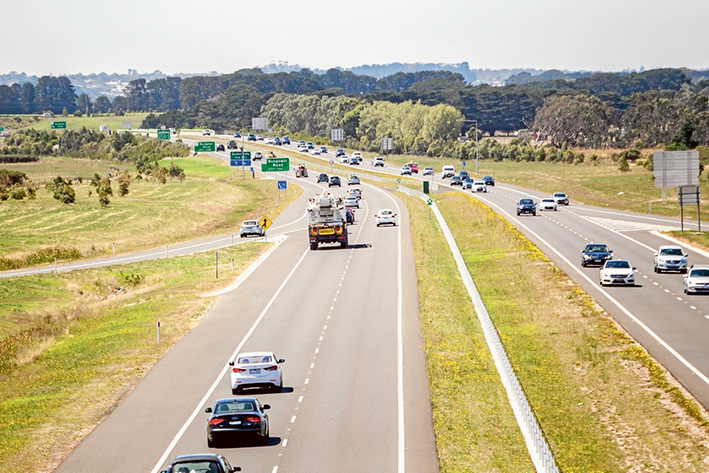A PENINSULA Link motorist booked for speeding has used his car’s dash cam and satellite pictures to measure the distance between two points to calculate his actual speed – more than 10kph below that stated on his fine.
The calculation will add fuel to the fire of discontent over the dozens of contentious fines meted out to freeway drivers, many of who have joined the Peninsula Link 108 group which is planning a class action.
Allan Tadich, of Kilsyth, said he received an infringement notice for doing 112kph as he passed the Loders Rd static camera on 22 December.
“This seemed incorrect as I had my car’s cruise control set at 100kph,” he said.
“Fortunately, I had the dash-cam on and was able to review the footage later.”
Determined to prove the camera wrong, Mr Tadich used his dash cam and Google Earth to identify two easily recognisable points and cross referenced them.
He then calculated the elapsed time taken to drive between the two points to within 0.5 of a metre.
Using the formula speed equals distance divided by time he was able to calculate his actual speed at 101.5kph plus-or-minus 0.5kph.
“I have used this as the basis of my appeal and am calling for an internal review.
Late Friday, Mr Tadich received some good news: The officer in charge of the traffic control branch had agreed to suspend his infringement pending “further investigation”.
Mr Tadich said to be clocked supposedly at 112kph meant he could have been driving as fast as 115kph, using the plus-or-minus 3kph built into the cameras.
He says this is ridiculous. “I have a high level of confidence that they are clearly wrong,” he said.
“The static camera at Loders Rd has not been tested for 11 months and so, surely, is due for recalibration.”
Cameras usually are tested every 12 months, meaning this camera is due for testing this month.
He said a speed of 115kph would have been picked up by the point-to-point cameras, which calculate a car’s average speed over a certain distance.
Road Safety Camera Commissioner John Voyage said the Peninsula Link investigation “is indeed continuing”.
“We have analysed a substantial amount of data, but there is still more to go through,” he said. “We have received 96 complaints at this office, plus 12 that were received before the [Police] Minister [Lisa Neville] requested the investigation.
“We are most certainly carefully looking for where a problem could be.
“This involves carefully scrutinising every aspect of the road safety camera system along the Peninsula Link freeway.”


3 Comments
If this camera is more than 10% out of accuracy in less than 11 months in use OMG, How many innocent drivers have been fined at 1% out of accuracy. Meaning allowing for their 3 kph before booking someone then they may well be driving at 101kph (very easy to do and get fined), and this is still well within the time frame before the unit needs CHECKING and I feel there should be no more that 0-1.5 kph variation and then re-calibrate the unit.
I hope that everyone who got fined actually receives a refund, points redeemed and a personal written apology.
Are we really a revenue raising state? Make you wonder!
The Police have by 2010 fitting number plate detection technology to the front of police vehicles which could instantly provi8de feedback as to whether nor not a motor vehicle was unregistered and uninsured. For 1/2 a century Road transport authorities have issued windscreen registration stickers with a clearly visible expiration date to alert motorists when rego was up for renewal. Now the road transport authorities have stopped issuing windscreen registration stockers stating it would save Got approx.. 9 to 12 cents in the production of the stickers. Either Add to dictionary or inadvertently the effect is that motorists will forget when rego expires and incur very hefty fines, Considering the seriousness of an offense of being caught out with an unregistered and uninsured motor vehicle that GOV would have promoted the issue of windscreen rego stickers than discarding them, and makes me think whether this is a revenue raising
Stephen F. ‘Safety cameras’ are purely revenue raisers. I learned this some time back when the NSW government announced that revenue from a certain camera would go towards funding a certain hospital (IIRC, it was Westmead Children’s).
Now that’s not so bad, but the crunch came several months later when the government were crying because not enough people were getting fined.
Yes, you read that correctly. You see, they’d formed their budget for the hospital using an anticipated income from that camera. Not using the camera income as a ‘bonus’ or ‘top up’, but as actual part of the main funding for the hospital. When fewer people got caught speeding, the expected revenue did not eventuate. This led to government officials actually complaining that not enough people were breaking the law.